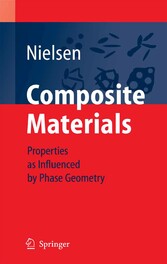Suchen und Finden
Overview
6
Readers Guidance
7
Contents
9
1 Introduction
14
1.1 Objectives of This Work
17
1.1.1 Summary of Composites Considered
18
2 Classification of Composites
19
2.1 Volume Concentrations
19
2.2 Geometry at Fixed Phase Concentrations
20
2.2.1 Geometrical Classification
21
2.3 Composites with Variable Geometry
22
2.3.1 Geometrical Classification
22
2.3.2 Some Composite Examples
26
3 Preliminaries on Stress/Strain
29
3.1 Stiffness
29
3.1.1 Dilute Suspension
31
3.2 Stress
32
3.3 Composite Sti.ness Estimated by SCS
32
4 Composite Stress and Geometry
35
4.1 Volumetric Stress
35
4.1.1 CSA-Composites
35
4.1.2 Any Composite – Geometry Function
36
4.1.3 Geometry Function and Shape Function
37
4.1.4 Shape Functions – A Closer Look
39
4.1.5 Summary
42
4.2 Deviatoric Stress
43
4.2.1 Stress and Geometry
43
4.3 Summary on Stress and Geometry
44
4.3.1 Stress
44
4.3.2 Geo-Function
44
5 Composite Stiffness and Geometry
46
5.1 Bulk Modulus and Shear Modulus
46
5.1.1 Porous Materials and Stiff Pore Systems
46
5.2 Young’s Modulus and Poisson’s Ratio
47
5.3 Special Composites and Observations
47
5.3.1 CSA-Composites
48
5.3.2 Composites with Special Shear Moduli Geo-Independent Bulk Moduli
48
5.3.3 Paul/Hansen versus Geo-Functions
49
6 Composite Eigenstrain/Stress
50
6.1 Basics
50
6.1.1 Simple Composites
51
6.2 General Geometry
51
6.2.1 Eigenstrain and Eigenstress
51
6.2.2 Pore Pressure in Porous Materials
52
7 Quantification of Geometry
53
7.1 Shape Factors
57
7.1.1 DC-Composites
57
7.1.2 CD-Composites
63
7.1.3 MM-Composites
64
7.2 Shape Functions and Geo-Path
67
7.2.1 Default
67
7.2.2 Alternative I
70
7.2.3 Alternative II
71
7.3 Geo-Paths
72
8 Composite Theory – Elasticity
74
8.1 Illustrative Examples
74
8.1.1 DC-CD Composite
74
8.1.2 Crumbled Foils Composite
76
8.1.3 Particulate (DC-DC) Composite
78
8.2 Other Examples
80
8.2.1 Cracks
80
8.2.2 Special DC-CD Composites Isotropy
84
8.3 FEM-Analysis versus Theory
87
8.3.1 FEM-Analysis
87
8.3.2 Particulate Composite
89
8.3.3 Defective Particulate Composite
91
8.3.4 Pearls on a String Composite
96
8.3.5 Grid Composite
100
8.3.6 Cracked Material
103
8.3.7 Discussion of FEM-Analysis
104
8.4 Conclusion
107
9 Composite Theory – Conductivity
108
9.1 Theory
108
9.2 Illustrative Examples
109
9.2.1 Porous Materials and Stiff Pore Systems
109
9.2.2 Dilute Porous Materials and Stiff Pore Systems
111
9.2.3 Cracked Materials (Soft and Stiff Cracks)
111
9.2.4 Crumbled Foils Composite
113
9.3 Theory versus Experiments
113
9.3.1 Chloride Diffusion in HCP and HCP with Silica Fume
113
9.3.2 Thermal Conductivity of Plane-Isotropic Fiber Composite
116
9.4 Theory versus SCS-Estimates
118
9.5 Conclusion
118
10 Simplified Composite Theory – Elasticity
121
10.1 Basis of Analysis
123
10.1.1 Geometry
123
10.1.2 Quantification of Composite Geometry
125
10.1.3 Preparation of Composite Analysis
129
10.2 Analysis
130
10.2.1 Bounds and Other Accurate Stiffness Expressions
131
10.2.2 Test of Theory
131
10.3 Illustrative Examples
133
10.3.1 Composites with Spherical Particles (CSAP)
134
10.3.2 Nearly CSAP Composites
134
10.3.3 Phase Symmetric Composites
135
10.3.4 Eigenstrain/Stress versus Geometry
140
10.3.5 Porous Materials
140
10.4 Theory and Experiments
145
10.4.1 Some Irregular Geometries Non-Flexible Geometry – Interference
145
10.4.2 Various Porous Materials
148
10.4.3 Sulphur Impregnated Cement/Silicate System
152
10.4.4 Salt Infected Bricks
154
10.4.5 Non-Flexible Particles in Particulate Composite
155
10.4.6 Defective Phase Contact in Concrete
157
10.4.7 Hydrating Cement Paste and Concrete
159
10.5 Conclusion
162
11 Simplified Composite Theory – Conductivity
163
11.1 Illustrative Example
163
11.1.1 On the Accuracy of Simplification
164
11.2 Applications
164
11.2.1 Thermal Conductivity of Fire-Brick
164
11.2.2 Electrical Conductivity of Binary Metallic Mixtures
164
11.2.3 Chloride Di.usion in Cement Paste System
166
11.3 Conclusion
169
12 Diagnostic Aspects of Theory
170
12.1 Stiffness
172
12.1.1 Examination of Sti.ness Expressions Isotropy Check
172
12.2 Conductivity
178
12.2.1 Examination of SCS-Expressions Spheres: Böttcher/ Landauer
178
12.3 Discussion
181
13 Aspects of Materials Design
184
13.1 Geometries versus Properties
184
13.2 Design
185
13.3 Illustrative Examples
185
13.3.1 Stiffness
185
13.3.2 Conductivity
187
13.4 Discussion
189
14 Viscoelasticity
190
14.1 Stress-Strain Relations
191
14.1.1 Analogy Young’s Modulus
192
14.1.2 Vibrations
194
14.2 Models of Viscoelastic Materials
196
14.2.1 Simple Models
197
14.2.2 Less Simple Models
197
14.3 Summary, Analysis, and Approximate Analysis
202
14.3.1 Approximate Analysis
203
15 Viscoelastic Composites
206
15.1 Composite Analysis
207
15.1.1 Accurate Analysis
207
15.1.2 Approximate Analysis
207
15.2 Applications
209
15.2.1 Porous Materials and Stiff Pore Systems
210
15.2.2 Particulate Composite
210
15.2.3 Mature Cement Concrete
211
15.2.4 Young Concrete
217
15.2.5 In.uence of Geometry on Viscoelastic Composite Behavior Particulate Composite versus Grid Reinforced Composite
217
15.2.6 Monomer Impregnated HCP and Porous Glass
222
15.2.7 Damping of Wood
225
15.3 Discussion
227
16 Final Remarks
228
A Elasticity
230
A.1 Isotropy
230
A.1.1 Composite Aspects
230
A.1.2 Stress-Strain
230
A.2 Cubic Elasticity
231
A.2.1 Poly-Cubic Elasticity
232
A.2.2 Composite Aspects
233
B Dilute Particulate Composites
234
B.1 Cubic Stiffness, Shape Parameters, and Stress
234
B.1.1 Particle Stress
235
B.1.2 Isotropic Stiffness, Shape Coefficients, and Stress
237
B.1.3 Particle Stress
237
C SCS-Analysis
238
C.1 Stiffness
238
C.1.1 Spherical Particles
239
C.1.2 Various Particle Shapes and Cracks
240
C.1.3 Multi-Shaped Particles
241
C.2 Other Physical Properties
242
C.2.1 Spherical Particles
243
C.2.2 Particles of Various Shapes and Cracks
243
C.2.3 Multi-Shaped Particles
245
D General Viscoelastic Models
246
E HCP and Concrete
248
E.1 Volume Models
248
E.2 Porosity of Hardening Cement Paste
249
Notations
251
References
254
Alle Preise verstehen sich inklusive der gesetzlichen MwSt.








